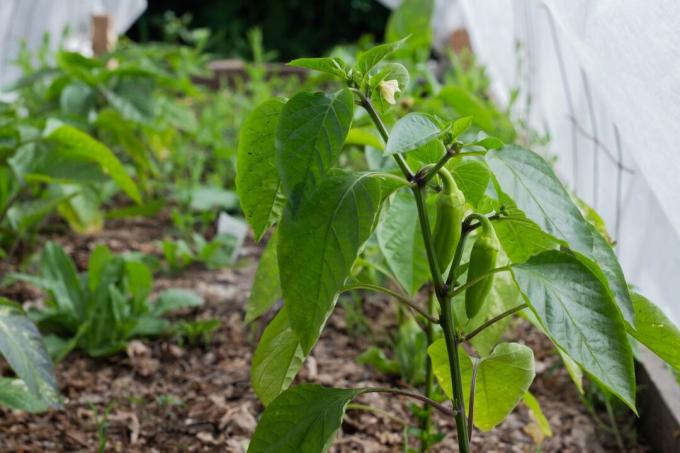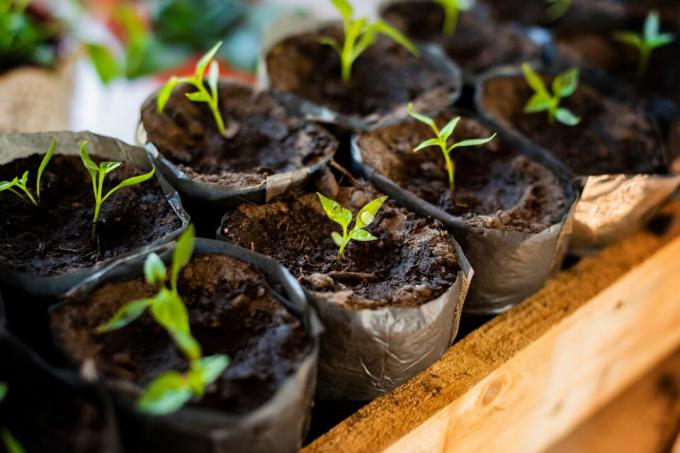You can also plant heat-loving peppers yourself at home. We will show you what to consider when growing peppers.

The paprika (Capsicum) is a member of the nightshade family (Solanaceae) and indispensable in most kitchens. In the vernacular, the colorful vegetable is often referred to as a "pod", which is actually a "berry". However, that does not change the fine, spicy taste and the many possible uses of this great fruit! We'll tell you how you can plant peppers yourself, what needs warmth-loving vegetables have and what you should consider when caring for peppers.
contents
-
Growing peppers: location and proper care
- Location for peppers
- Planting peppers: how to do it and when to do it
- Pour and fertilize peppers properly
- Skinned peppers
-
Propagate peppers yourself or buy pepper plants?
- Buy and sow pepper seeds
- Buy pepper plants
- Types of pepper: a great variety
-
Harvest and store peppers
- Let the peppers ripen
- Preserving and storing peppers
Growing peppers: location and proper care
Many hobby gardeners are a little skeptical about growing peppers because, next to aubergine, they are probably the most warm vegetable. However, there are enough arguments in favor of growing the colorful pod. Here you will learn step by step how you can successfully plant peppers yourself!
Location for peppers
Paprika loves soil rich in nutrients and humus. If you incorporate enough humus into the bed before planting your bell pepper seedlings, the nutrient requirements are covered by the time they flower.
Important: Note crop rotation! The bell pepper belongs to the nightshade family, just like potatoes, tomatoes and eggplant. In the crop rotation they tolerate Solanaceae not because soil-borne diseases can be transmitted (Verticilium, Fusarium, mildew i.a.). There should be a break of at least one year between two nightshade plants, ideally even three years.
Even more important than nutrient-rich and well-drained soil is a warm and sunny location. Ideally, you should plant your peppers on a south wall, where the sunlight can create a microclimate.
Note: The conditions for growing peppers are not met in all regions of Germany. Anyone who can plant peppers in the greenhouse is on the safe side.
Planting peppers: how to do it and when to do it
The best time to plant peppers is in mid to late May. When planting in the bed, a distance of approx. 50 cm must be adhered to. The ideal planting depth for peppers is between 5 and 8 cm. After planting, water the bed a first time. Before doing this, lightly press the soil around the planted seedlings to give the fine roots better initial contact with the water.

Note: You should definitely support your pepper plants with small stakes to protect them from kinking.
Pour and fertilize peppers properly
The peppers want to be kept moist permanently. You should urgently avoid waterlogging. It is best to water the pepper plants several times a day to ensure even moisture.
Before planting, the pepper bed should be generously humus or a primarily organic bio-fertilizer like ours Plantura organic tomato fertilizer be added. The peppers should then do without fertilization until they bloom. As soon as the first flowers appear, you should give your peppers a little support again. The Plantura organic tomato fertilizer. More about the Fertilizing pepper plants can be found in our special article.
Tip: The first flower that the pepper plant forms is called the “king's flower”. Remove these after blooming so that not all of the energy is channeled into the main shoot. The greater the chance that several peppers will form.
Skinned peppers
Opinions are divided when it comes to “skimming”. Pruning means removing small side shoots that grow in the leaf axils of the main shoot. Removing the side shoots promises a better harvest yield because less energy is invested in green biomass. With other plants (e.g. B. Tomato) pricking out is important in order to achieve good yields. That Skinning the peppers is not absolutely necessary, but it doesn't hurt and it is definitely worth a try!

The most important steps in pepper planting in a nutshell:
- Note crop rotation!
- Prepare the bed in late autumn; Work in compost; Let lie fallow over winter
- Place the pepper plants in the bed in the middle / end of May; 50 cm distance; 5-8 cm setting depth
- Water regularly; Avoid waterlogging
- Make sure to support the peppers!
Propagate peppers yourself or buy pepper plants?
You can grow paprika plants from seeds yourself or buy paprika seedlings in well-stocked specialist shops. We explain the differences and what to watch out for.
Buy and sow pepper seeds
Paprika seeds are available in every well-stocked specialist shop or at online gardeners. A bag of seeds costs approx. 1.30 euros. Sow the pepper seeds in small pots or planters. Humus-rich compost is suitable as a planting medium. However, additional fertilization should not be used. Cover the freshly sown seeds with transparent foil or Cover off. So you can use the greenhouse effect to ensure the paprika seedlings have the easiest possible start.

Attention: The optimal germination temperature is 25 ° C, so a warm place in the greenhouse or on the window sill at home is absolutely necessary! When the pepper plants are approx. 5 centimeters tall, they can be pricked out by hand or with the help of tweezers. Put the plants in somewhat larger pots, where you can spend the rest of the time until planting out.
Buy pepper plants
Bell pepper plants are available in every major garden center or online retailer. Depending on the variety, you can pay between 3 and 6 euros for a fully grown pepper plant. The seedlings from the trade are usually grafted, which means that they have better growth properties from the start. Even if it is a little more expensive to buy ready-made seedlings, the harvest is usually more successful and one saves the laborious process of grafting.
Types of pepper: a great variety
From mini peppers to fiery chilli: the peppers come in a wide variety of varieties. We have put together an exclusive selection of the most famous and exotic varieties for you:

- Tall sweetheart: juicy, regional paprika variety; robust; suitable for colder regions
- Purple Beauty: purple variety of pepper; juicy and tasty; suitable for tub cultivation
- Sweet chocolate: new, exotic variety; very sweet in taste; chocolate brown
- Jalapeno: most famous chilli variety; hot and spicy in taste
- Black Pearl: Mini bell pepper pods; suitable as a house and balcony plant
You will find many more great paprika varieties in our Variety Articles.
Harvest and store peppers
The best time for the bell pepper harvest is in late summer, but the colorful pods can still be harvested until October. The pepper harvest itself is comparatively simple: Simply cut the pods a few centimeters above the stem with a sharp knife or scissors. Make sure that the cut is smooth so that the pepper plant remains as intact as possible.

Let the peppers ripen
Often the weather conditions do not allow it or you are simply too impatient to wait until the peppers are really ripe. It is best to harvest the peppers when they are ripe so that they can be fresh, crisp and colorful at the same time. If you want to help a little, you can try the following tips:
- Put peppers in a bag with apples: Apples give off the natural phytohormone ethylene, which can accelerate the peppers' ripening process. Most nightshade plants (with the exception of the tomato) do not respond as well to this treatment or become mushy quickly. It is still worth a try
Tip: If you notice early enough that the attempt has failed, you can always whip up a delicious salsa from the matured peppers - Put the peppers in a closed box in a moderately warm place: Put your peppers in a box to ripen and seal it.
With a little luck, the warmth and the reduced light radiation can contribute to the post-ripening.
Note: For this method to have a chance, a colored ripe must be visible on the peppers.
Preserving and storing peppers
-
Put in peppers
Peppers are great for pickling. To do this, they need to be washed, cut and blanched in boiling salted water for a few minutes. Let your blanched peppers cool while you prepare the marinade. Good olive oil and two to three tablespoons of vinegar are particularly suitable for this. The marinade can be refined with garlic, salt, pepper and other spices as you like. Finally, put your peppers in a sealable container and fill this with your marinade so that the peppers are completely covered. Your peppers will keep for about a year in this way.

-
Freeze peppers
Bell peppers can also be frozen. To do this, they should be briefly blanched beforehand so that they do not become too mushy when thawing and keep their color.
-
Dry peppers
Another way to preserve peppers is by drying them. To do this, cut the peppers into strips and spread them out on a baking sheet. At a constant 50 ° C, the peppers should then "dry out" for 6 to 8 hours until they have lost most of their moisture. Paprika can either be dried in a standard oven or in a special drying oven.
-
Boil down / preserve peppers
Of course, you can also boil down or boil your peppers. can. As already described under “Inserting peppers”, wash, cut and blanch your peppers. Then put the prepared pods in a mason jar and pour this with boiled salt water until the jar is full. Finally, let the closed jar stand in the boiling water bath for another 20 minutes, and that's it!
Bell pepper plants can benefit from mixed cultivation with the right neighbors for a more abundant harvest. Our article tells you which plants are involved good neighbors for peppers and which plant combinations you should avoid.



